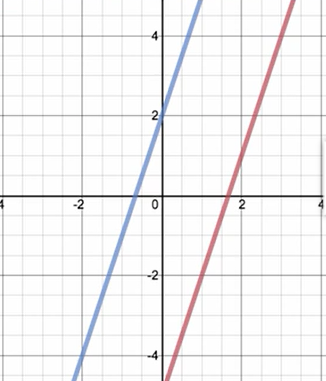Table of Contents |
Systems of equations have applications in economics, physics, and engineering. A system of linear equations consists of two or more equations with the same variables considered at the same time. This means that the equations in a system are graphed together on a single coordinate plane. The solution to this system of equations is the solution that satisfies all individual equations in the system.
EXAMPLE
Below you see a system of equations and its graphs. The point of intersection of the lines represents the solution to the two equations of the lines. The intersection point represents an x value and y value that can be substituted into each equation in the system to yield a true statement.

EXAMPLE
In this next example, you see a graph representation of the system of equations y equals 3x minus 5 and y equals 3x plus 2. These two lines are parallel, meaning they do not have an intersection point, which in turn means there is no solution to the system of equations.

It is possible to solve a system of equations by graphing the equations in the system, then finding the intersection point of the lines.
IN CONTEXT
Suppose a company is analyzing supply and demand data for their product. You can utilize a system of equations that represent the price of the product in relation to the quantity supplied and the quantity demanded, in order to represent the situation. In the following equations, the first equation represents the demand for the product, while the second equation represents the supply of the product.

To solve, you can graph both equations and find the intersection point. In the first equation, the y-intercept is 60. Therefore, you have a point at (0, 60). Next, use your slope, which is -1 over 2, to find your second point. Since the graph uses intervals of 5, you move down 5 and over 10 from the y-intercept to place your second point. Lastly, connect both points with a line.

In the second equation, the y-intercept is 0 because there is no written b value. Therefore, you have a point at the origin (0, 0). Use your slope, which is 3 over 2, to find your second point. From your y-intercept, you move up 3 and over 2 to place your second point. Lastly, connect both points with a line.

You can see that your lines intersect at the point (30, 45), which means that the solution to the system is x equals 30 and y equals 45. This is where the supply and demand are equal, and the company will maximize their profits by setting the price at $30 and selling a quantity of 45 units.

You can verify your solution by substituting it into both equations to see if they yield true statements, as shown below. Simplifying on both sides provides 45 equals 45; therefore, your solution of x equals 30 and y equals 45 is correct.


Source: This work is adapted from Sophia author Colleen Atakpu.